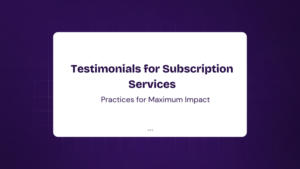The Art of the Gentle Nudge
Ah, the delicate dance of following up on a testimonial request. You send that initial email, full of hope, expecting a glowing response within hours. Days pass. Crickets. Maybe they missed it? Maybe they’re busy? Or—worst-case scenario—maybe they saw it, shrugged, and thought, “Eh, I’ll do it later.”
Now, you’re stuck in a tricky spot. You need their testimonial, but you also don’t want to sound desperate. So how do you follow up without being that person who pesters them into ignoring you entirely?
That’s exactly what we’re going to uncover. From strategic timing to crafting the perfect follow-up message, this guide will help you collect those much-needed customer testimonials without coming off as pushy.
Why Testimonials Matter More Than Ever
Before we dive into the follow-up strategy, let’s take a moment to appreciate why testimonials are so important.
According to BrightLocal, 98% of consumers read online reviews before making a purchase decision. Testimonials act as trust signals, helping potential customers feel more confident about your product or service. A well-placed testimonial can increase conversions by 34% and even boost SEO rankings.
Yet, despite their importance, getting customers to actually write them can feel like pulling teeth. But don’t worry—that’s where a strategic follow-up approach comes in.
Timing Is Everything: When to Follow Up on a Testimonial Request
The first rule of follow-up? Timing. You don’t want to rush them, but you also don’t want to wait so long that they forget.
Ideal Follow-Up Timelines:
- 3-5 Days After the Initial Request – This is the sweet spot. They’ve likely seen your request but may have forgotten to respond. A gentle nudge here keeps the momentum going.
- 10 Days Later – If they still haven’t replied, a second follow-up is warranted. This one should be slightly more personalized.
- One Month Later – If there’s still no response, a final follow-up with a different approach (perhaps offering an incentive) can help.
Now that we’ve got timing down, let’s look at what to actually say.
Crafting the Perfect Follow-Up Message (Without Sounding Annoying)
Your follow-up message should be polite, appreciative, and make it easy for them to respond.
The Gentle Reminder
Subject: Quick Follow-Up – We’d Love Your Feedback!
Hi [Customer’s Name],
I just wanted to follow up on my previous email about your experience with [Product/Service]. We’d absolutely love to hear your thoughts and share your story with others who might be considering us.
It won’t take more than a couple of minutes, and we truly appreciate your time! You can submit your testimonial here: [Insert Link]
Thank you so much, and let me know if you have any questions!
Best,
[Your Name]
Adding Value
Subject: Your Feedback Could Help Others!
Hi [Customer’s Name],
I know you’re busy, so I completely understand if this slipped through the cracks! But I wanted to reach out again because your feedback could genuinely help others who are considering [Product/Service].
If you have a moment, we’d love to hear about your experience. You can share your thoughts here: [Insert Link]. It only takes a minute, and we’d be incredibly grateful!
Thanks so much,
[Your Name]
The Last Attempt with an Incentive
Subject: A Small Thank You for Your Time!
Hi [Customer’s Name],
I promise this is my last follow-up! We really value your feedback, and to show our appreciation, we’d love to offer you [discount/freebie/gift] in exchange for a quick testimonial.
You can submit it here: [Insert Link] – and it’ll take just a minute. Thanks again for being such an awesome customer!
Best,
[Your Name]
Beyond Email: Alternative Ways to Follow Up on Testimonials
If emails aren’t getting responses, try different approaches:
- Send a Text Message: If you have their phone number, a short SMS reminder can be effective.
- Use Social Media: A friendly DM on LinkedIn, Instagram, or Twitter can work wonders.
- Call Them (if appropriate): If you have a good relationship with the customer, a quick call can speed things up.
- In-Person Follow-Ups: If you meet them at an event, gently remind them about the testimonial.
What If They Still Don’t Respond?
Even after three follow-ups, some customers just won’t respond. Here’s what you can do:
- Move on and focus on others – Not every customer will be willing to write a testimonial, and that’s okay.
- Repurpose other feedback – If they’ve left a review elsewhere (Google, Yelp, social media), ask for permission to use it.
- Try a video or audio testimonial – Some customers prefer speaking over writing.
FAQs
How many times should I follow up on a testimonial request?
Ideally, you should follow up three times—once after 3-5 days, again after 10 days, and a final attempt around a month later.
What if a customer says they’ll write a testimonial but never does?
Gently remind them with a follow-up email or message. If they still don’t respond, move on and focus on other customers.
Should I offer an incentive for testimonials?
It depends. Some businesses offer small incentives (like discounts or freebies), but be careful not to make it seem like you’re “buying” reviews.
How do I ask for a video testimonial instead of a written one?
Simply ask! Many customers are more comfortable talking than writing. Provide an easy way for them to record and submit a short video.
Can I use customer feedback from emails or chat messages as testimonials?
Yes! Just be sure to get their explicit permission before publishing it.
What’s the best way to collect testimonials?
The easiest method is a short online form with a few guiding questions. Keep it simple, and make it effortless for customers to submit their feedback
Follow Up Like a Pro, Not a Pest
Following up on a testimonial request doesn’t have to feel awkward or pushy. By keeping your messages polite, appreciative, and to the point, you’ll increase your chances of getting responses without annoying your customers.
The key is to make it easy, valuable, and even rewarding for them. So go ahead, send that follow-up—your future customers (and your conversion rates) will thank you.



